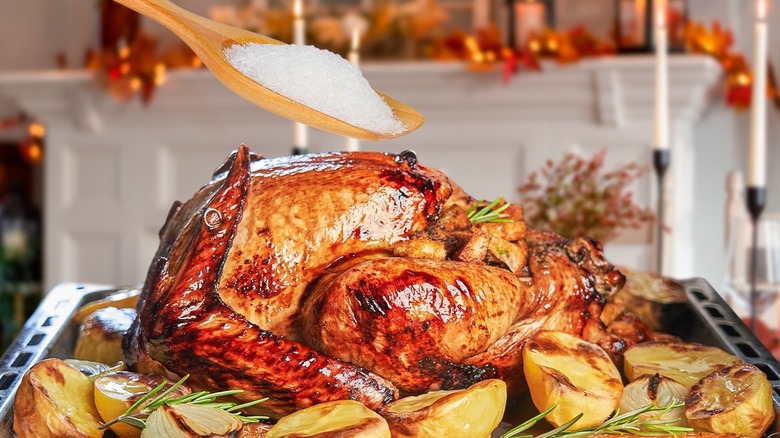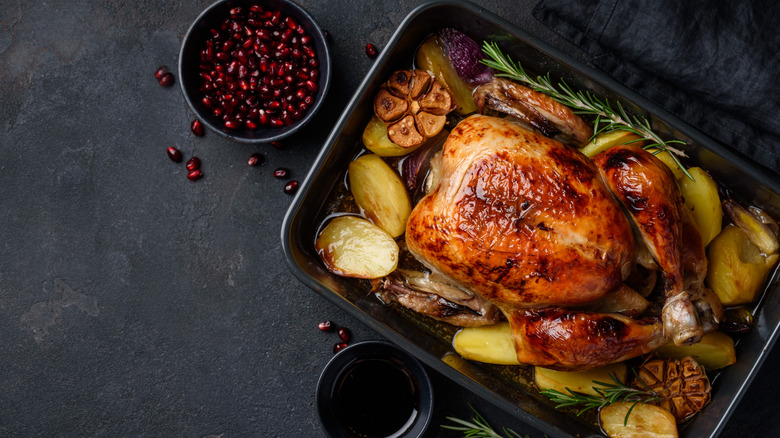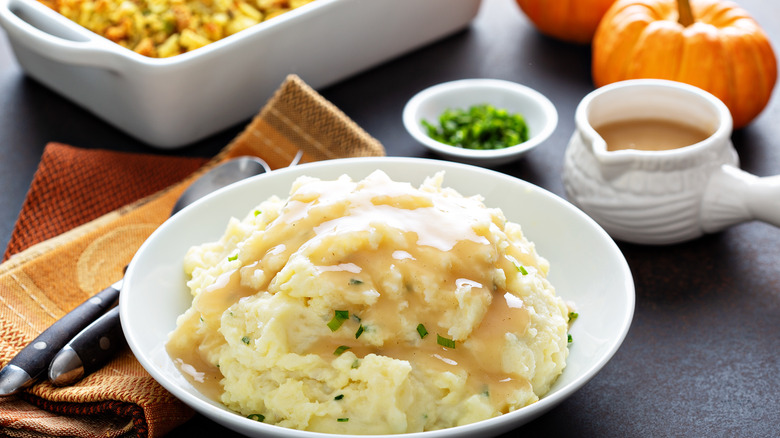MSG Is The Secret Ingredient To Take Your Holiday Dishes To The Next Level
We may receive a commission on purchases made from links.
Did you know there's a secret ingredient that can take your holiday dishes to the next level? It's none other than the often misunderstood monosodium glutamate (MSG). As harmless as the salt, sugar, and pepper in your pantry, MSG has had a historically bad rep, primarily due to the misconception that is unhealthy. But this savory add-in can elevate a range of dishes, including the popular foods we enjoy around the holidays.
To explore how we can best use this once-misunderstood and now exonerated flavor enhancer, Tasting Table chatted exclusively with experts, including Chef Jon Kung, a self-taught cook, culinary influencer, and best-selling author of "Kung Food," and Chef Christopher Koetke, a corporate executive chef at Ajinomoto North America. Kung and Koetke shared their insights and tips on integrating the transformative MSG into traditional and beloved holiday dishes.
"Umami is one of our five basic tastes and contributes mightily to delicious food. MSG is basically pure umami. As such, MSG is ideal to incorporate into holiday dishes because of how versatile it is. It is great to add to roasted vegetables, hearty gravy or even to desserts where it can contribute a unique savory component," Koetke emphasizes. Meanwhile, Kung stresses how just a touch of MSG enhances flavors and can make your savory holiday dishes, like ham and Brussels sprouts, taste their best.
The best way to use MSG in a holiday turkey, stuffing, or gravy recipe
If you'd like to start incorporating MSG into your holiday turkey recipe, experts Jon Kung and Christopher Koetke provide compelling ways to do so. Kung advises that once you're comfortable and familiar with using MSG, add it to your turkey brine or basting liquids. This will enhance the bird's inherent flavors, ensuring its succulence. Koetke recommends infusing MSG directly into the turkey rub. His recipe is a well-balanced mixture of MSG, salt, black pepper, garlic powder, brown sugar, cumin, and thyme, which he rubs liberally onto the turkey before baking it with a bottle of ale and butter. This method seasons the turkey and imparts a rich, complex flavor profile with enhanced umami.
The versatility of MSG extends to turkey gravy and its stuffing as well. Kung notes that MSG makes "meaty things taste meatier," adding a robust, mouthwatering quality to these dishes, like sausage stuffing. Koetke echoes this sentiment. He uses leftover or stale bread for his stuffing, enriching it with chicken or turkey broth instead of water and seasoning it with MSG. "The MSG adds an irresistible savory component to the stuffing, again because it is pure umami," he states. As for his gravy, just a pinch of MSG will add layered depth and savoriness.
How MSG impacts the flavor of holiday mashed potatoes and veggies
Monosodium glutamate's versatility extends to mashed potatoes and veggie side dishes that round out the holiday meal. Christopher Koetke recommends adding MSG simultaneously when you season your dish with salt and pepper for all cruciferous vegetables. He adds, "One of my favorite vegetable sides is my maple caramelized Brussels sprouts with whole grain mustard recipe." As for mashed potatoes, Koetke likes to incorporate goat cheese, which inherently, like parmesan cheese, has a high glutamate level and packs even more umami punch when paired with MSG.
When asked to provide recommendations on incorporating MSG into plant-based holiday side dishes, Jon Kung humorously states, "What do you think the phrase 'where has this been all my life?' tastes like? It tastes like MSG in mashed potatoes!" If this doesn't convince you to add MSG to your mashed potatoes, we don't know what will. Besides mashed potatoes, Kung feels braised vegetables would also benefit from adding some MSG.
How to determine the right amount of MSG to add
If you're wondering about the right amount of MSG to add to a dish to enhance flavor without overwhelming it, Christopher Koetke has some sound advice. He recommends starting with a small amount and adjusting based on taste. "As a starting point, about half a teaspoon of MSG is effective for enhancing the flavor of a pound of meat or four to six servings of vegetables, casseroles, or soups. But always taste and add more as needed," he says. Koetke also suggests creating a mix that's half MSG and half salt. So, instead of adding a teaspoon of salt, use half a teaspoon of MSG and half a teaspoon of salt. "This achieves a great taste balance and reduces sodium by 40% compared to straight salt," he teaches. He then adds, "When adding MSG, you can follow some of my recipes, or for general advice, go to MSGdish.com."
Jon Kung offers similar advice, suggesting you practice and start simple with dishes you can easily taste, like soups or scrambled eggs. "And go slow! Pinch by pinch if need be," he concludes.
As you sprinkle MSG into your holiday recipes, note that you're not just enhancing flavors but also partaking in the culinary vindication of an ingredient that has been unjustly criticized for too long. This holiday season, let MSG play its part in creating dishes as rich in taste as they are in history.



